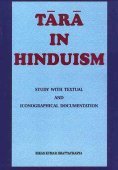Naradapancaratra, Nāradapañcarātra, Narada-pancaratra: 4 definitions
Introduction:
Naradapancaratra means something in Hinduism, Sanskrit. If you want to know the exact meaning, history, etymology or English translation of this term then check out the descriptions on this page. Add your comment or reference to a book if you want to contribute to this summary article.
Alternative spellings of this word include Naradapancharatra.
In Hinduism
Vaishnavism (Vaishava dharma)
Source: Pure Bhakti: Bhagavad-gita (4th edition)Nāradapañcarātra (नारदपञ्चरात्र) refers to “a narrative in five parts: knowledge that gives the supreme truth;knowledge that awards mukti; knowledge that awards bhakti;knowledge that awards mystic perfection and knowledge in the mode of ignorance that is interspersed with numerous mantras, stotras and kavacas”. (cf. Glossary page from Śrīmad-Bhagavad-Gītā).

Vaishnava (वैष्णव, vaiṣṇava) or vaishnavism (vaiṣṇavism) represents a tradition of Hinduism worshipping Vishnu as the supreme Lord. Similar to the Shaktism and Shaivism traditions, Vaishnavism also developed as an individual movement, famous for its exposition of the dashavatara (‘ten avatars of Vishnu’).
Languages of India and abroad
Sanskrit dictionary
Source: Cologne Digital Sanskrit Dictionaries: Aufrecht Catalogus Catalogorum1) Nāradapañcarātra (नारदपञ्चरात्र) as mentioned in Aufrecht’s Catalogus Catalogorum:—vaiṣṇava tantra. It consists of Lakṣmīsaṃhitā, Jñānāmṛtasārasaṃhitā, Paramāgamacūḍāmaṇisaṃhitā, Pauṣkarasaṃhitā, Padmasaṃhitā, Vṛddhabrahmasaṃhitā. [Mackenzie Collection] 142. K. 44. B. 4, 62. Ben. 41. Bik. 709. Rādh. 18. 30 (svalpa). Oudh. Viii, 28. Xvi, 136. Mysore. 3. Bp. 8. Quoted by Nīlakaṇṭha. Paramāgamacūḍāmaṇisaṃhitā Io. 147. Bp. 269. Nāradapañcarātre Jñānasāre Kṛṣṇastavarāja.
—Kṛṣṇastotra.
—Kṛṣṇāṣṭottaraśatanāmastotra.
—Gopālastotra.
—Trailokyamaṅgalakavaca.
—Nṛsiṃhakavaca. Oudh. Xiv, 100.
—Rādhākavaca. Bṛhannāradapañcarātra. L. 1704.
2) Nāradapañcarātra (नारदपञ्चरात्र):—[tantric] Paramāgamacūḍāmaṇisaṃhitā. Gb. 48. Pādmasaṃhitā. Io. 736. Stein 92. 308 ([fragmentary]). Pauṣkarasaṃhitā. Io. 736. Five chapters of the same on images of deities, with a Telugu
—[commentary] by Peḍḍanācārya. Io. 2579.
Nāradapañcarātra (नारदपञ्चरात्र):—[=nārada-pañca-rātra] [from nārada] n.
[Sanskrit to German]
Sanskrit, also spelled संस्कृतम् (saṃskṛtam), is an ancient language of India commonly seen as the grandmother of the Indo-European language family (even English!). Closely allied with Prakrit and Pali, Sanskrit is more exhaustive in both grammar and terms and has the most extensive collection of literature in the world, greatly surpassing its sister-languages Greek and Latin.
See also (Relevant definitions)
Partial matches: Ratra, Narada, Pancaratra.
Starts with: Naradapancaratrasara.
Full-text (+2): Pancaratra, Vinapani, Vidhiputra, Paramagamacudamanisamhita, Jayakhya-samhita, Padmatantra, Radhikakavaca, Kundaprakarana, Gopalastotra, Vriddhabrahmasamhita, Lakshmisamhita, Padmasamhita, Paushkarasamhita, Jaya, Krishnastavaraja, Kriyakanda, Jnanamritasarasamhita, Radhakavaca, Jitamtestotra, Krishnashtottarashatanaman.
Relevant text
Search found 10 books and stories containing Naradapancaratra, Nāradapañcarātra, Naradapanca-ratra, Nāradapañca-rātra, Narada-pancaratra, Nārada-pañcarātra; (plurals include: Naradapancaratras, Nāradapañcarātras, ratras, rātras, pancaratras, pañcarātras). You can also click to the full overview containing English textual excerpts. Below are direct links for the most relevant articles:
Shri Gaudiya Kanthahara (by Srila Bhaktisiddhanta Sarasvati)
Bhakti-rasamrta-sindhu (by Śrīla Rūpa Gosvāmī)
Verse 1.1.34 < [Part 1 - Qualities of Pure Bhakti (bhagavad-bhakti-bheda)]
Verse 1.4.18 < [Part 4 - Devotional service in Love of God (prema-bhakti)]
Verse 1.2.155 < [Part 2 - Devotional Service in Practice (sādhana-bhakti)]
Chaitanya Bhagavata (by Bhumipati Dāsa)
Verse 2.9.50 < [Chapter 9 - The Lord’s Twenty-One Hour Ecstasy and Descriptions of Śrīdhara and Other Devotees’ Characteristics]
Verse 2.6.173 < [Chapter 6 - The Lord’s Meeting with Advaita Ācārya]
Verse 3.1.19 < [Chapter 1 - Meeting Again at the House of Śrī Advaita Ācārya]
Bhajana-Rahasya (by Srila Bhaktivinoda Thakura Mahasaya)
Text 21 < [Chapter 5 - Pañcama-yāma-sādhana (Aparāhna-kālīya-bhajana–kṛṣṇa-āsakti)]
Text 14 < [Chapter 4 - Caturtha-yāma-sādhana (Madhyāhna-kālīya-bhajana–ruci-bhajana)]
Text 42 < [Chapter 2 - Dvitīya-yāma-sādhana (Prātaḥ-kālīya-bhajana)]
Shrimad Bhagavad-gita (by Narayana Gosvami)
Verse 16.23 < [Chapter 16 - Daivāsura-sampada-yoga]
Verse 6.31 < [Chapter 6 - Dhyāna-yoga (Yoga through the Path of Meditation)]
Verse 8.28 < [Chapter 8 - Tāraka-brahma-yoga (the Yoga of Absolute Deliverance)]
Bhagavad-gita-rahasya (or Karma-yoga Shastra) (by Bhalchandra Sitaram Sukthankar)
Related products
